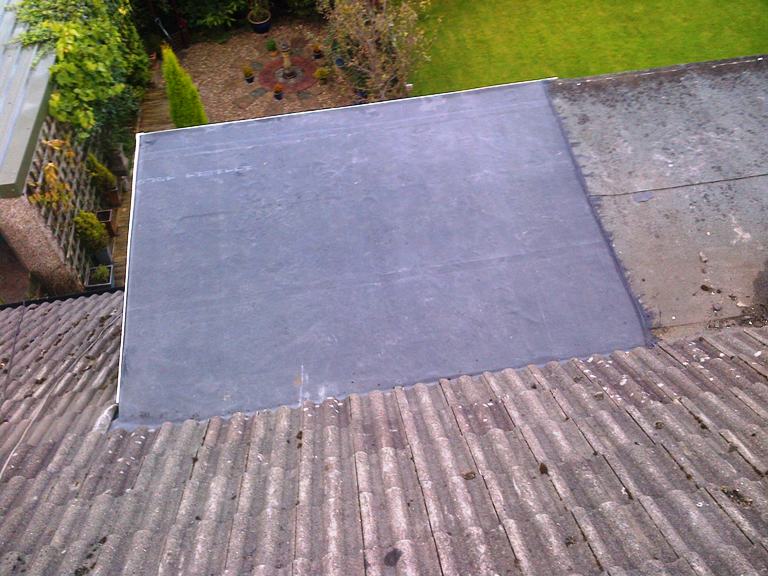Rubber roofing has several applications, and the most common are low-sloped and flat roofs. You should note that traditional shingles are great when it comes to repelling moisture on steep roofs by using the help of gravity. However, shingles fail to create the form of watertight seal required to protect a flat roof or a low-pitched roof from water.
On flat or low-sloped roofs, most contractors usually utilize specially-manufactured roofing materials that are made of PVC or rubber. This type of roofing is called rubber roofing and is available at Rubber Roofing Direct. This post discusses rubber roofing.

The benefits of rubber roofing
Rubber roofing or single-ply rubber roofing is a suitable material for low-sloped and flat roofs as they are water resistant and durable. The rubber roofing material regardless of whether it has plastic polymers or synthetic rubber polymers is specifically designed to protect your low-sloped roof from water damage.
No doubt, rubber roofing has several benefits. Rubber roofing material can last between twenty and twenty-five years on average but some can reach up to fifty years. Also, rubber roofing is easy to clean and maintain. It also gives great energy savings, and improved curb appeal, and requires a short time to install them.
Rubber roofing has many applications and uses. The main application for rubber roofing is on low-sloped and flat roofs. This is especially true where shingle roofing is not the right option. Remember that shingle roofing can be an ideal option for steep-pitched roofs, but not for low-sloped roofs. This is because shingle roofing utilizes a stacked formation, meaning you have to place one shingle on top of the other and should have overlapping ends. This is the proper design to help to repel water when it moves downwards off your roof.
On flat or low-sloped roofs, water can move in different directions and get into the shingles to cause leaks. Rubber roofing is an ideal option for roofs that may not be suitable to use shingles. Rubber roofing materials can also repel moisture and even protect your structure below from pooling water.
It’s worth noting that rubber roofing does not work well only for flat roofs. You can also use rubber roofing on pitched roofs when you try to extend the lifespan of the current roof structure and enhance the value of your property.
You can usually apply rubber roofing on sloped roofs over the top of the current shingles. Your roof installer can place a layer of insulation on the shingles and then apply the rubber membrane. The good thing is that this option can save you cash over time because rubber roofing can last longer than other kinds of roofing materials. Another benefit of installing rubber roofing on the shingled roof is that it can reduce your energy costs. The material can insulate and deflect heat away from your house.
Metal roofing is another great low-sloped and flat roofing option. The good thing is the metal roofing can last several years, though it can be expensive to replace it when it becomes leaky, rusted, or damaged. And, if your metal roof is damaged, then you should consider replacing it with a rubber roof. Instead of tearing off the current metal roof, you can decide to install rubber roofing over the top. A metal roof that has a rubber roof can enhance curb appeal and lower energy costs significantly.
Different types of rubber roofing
Almost all modern flat roofs tend to have rubber roofing membranes. You should remember that not all rubber roofs are made of rubber and they are usually made differently.
Ethylene propylene diene polymer (EPDM) is considered to be the most popular flat roof material out there. The good thing about EPDM is that it has a long lifespan. The truth is that EPDM can last longer than any other rubber roofing material. Also, EPDM is regarded as the original rubber roofing product, meaning it has been around for many years. EPDM is also affordable. This material is a lower-cost rubber roofing option.
One of the problems with EPDM roofing is that it absorbs heat. Most of the EPDM materials are black, so they provide less heat protection than other forms of rubber roofing materials. If you live in hot areas, it’s a good idea to choose white material, but it comes at an extra cost. EPDM seams can also be sealed with tape or adhesive, leaving them prone to leaking compared with hot air-welded seams.
Thermoplastic polyolefin (TPO) is another roofing material. This single-ply roofing material is quite similar to EPDM; though tends to be different in many ways. Firstly, TPO is a new material in the roofing industry, meaning that it has not been time-tested compared to EPDM roofing. But TPO was made to be a more energy-efficient and economical alternative to most other rubber roofing materials.
TPO is flexible and durable. It is highly flexible, so it can withstand impacts and other forms of potential damage. Even better, TPO doesn’t have some of the chemicals utilized to make other roofing materials, such as chlorine. Also, it’s UV resistant, which means that you can utilize less energy to cool down your house during the summer. Above all, TPO is environmentally friendly as it is 100 percent recyclable.
TPO is hot air-welded, so the seams are flexible, strong, and highly water-resistant. In most cases, the seams of TPO roofs can be at least four times stronger than EPDM seams that need to be sealed by utilizing adhesives. You can find TPO in white color, but it can also be produced in black or grey for aesthetic purposes.
The drawback of TPO roofing is that it’s a new technology. TPO was first launched in the roofing industry around the 1990s. This makes this roofing material a relatively new rubber roofing material.
Another problem with TPO is that most manufacturers are still trying to find the best formulation for their customers and businesses. You can find some manufacturers that make TPO products that are affordable but more prone to failure. Once you install a TPO roof, you need to find a roofing contractor who utilizes a high-quality TPO product.







